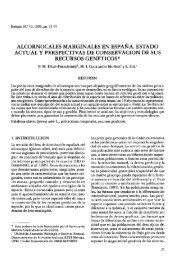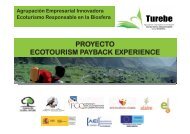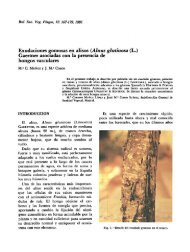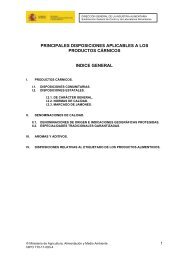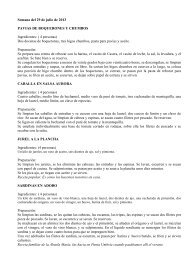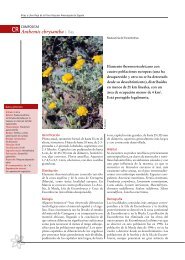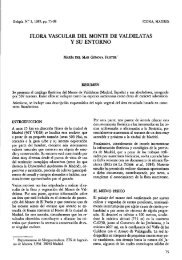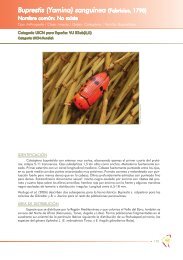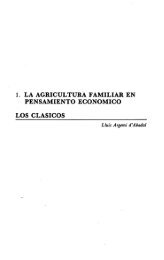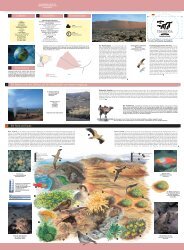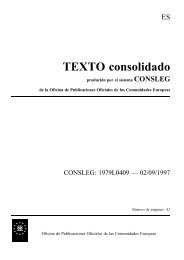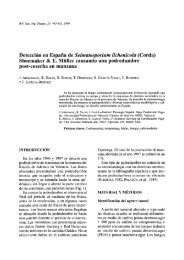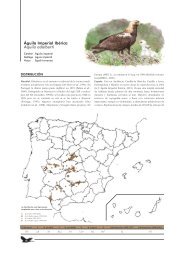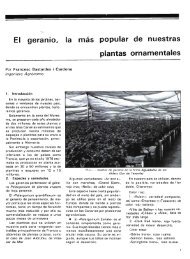Los métodos moleculares en el estudio de la sistemática y filogenia ...
Los métodos moleculares en el estudio de la sistemática y filogenia ...
Los métodos moleculares en el estudio de la sistemática y filogenia ...
Create successful ePaper yourself
Turn your PDF publications into a flip-book with our unique Google optimized e-Paper software.
574<br />
At<strong>la</strong>s y Libro Rojo <strong>de</strong> los Anfibios y Reptiles <strong>de</strong> España<br />
ciones filog<strong>en</strong>éticas <strong>de</strong> Gallotia y a <strong>la</strong> evid<strong>en</strong>cia empírica adicional <strong>de</strong> <strong>la</strong> longitud d<strong>el</strong> trayecto y t<strong>en</strong>i<strong>en</strong>do <strong>en</strong> cu<strong>en</strong>ta<br />
<strong>la</strong> r<strong>el</strong>ativam<strong>en</strong>te baja capacidad <strong>de</strong> dispersión <strong>de</strong> los <strong>la</strong>cértidos <strong>en</strong> comparación con otros reptiles (ARNOLD,<br />
2000; CARRANZA et al. 2000), pue<strong>de</strong> concluirse que lo más probable es que <strong>la</strong> colonización <strong>de</strong> <strong>la</strong>s Is<strong>la</strong>s Canarias<br />
por parte <strong>de</strong> Gallotia fuese <strong>en</strong> s<strong>en</strong>tido este-oeste, colonizándose <strong>la</strong>s tres áreas biogeográficas una a continuación<br />
<strong>de</strong> <strong>la</strong> otra (sigui<strong>en</strong>do un mod<strong>el</strong>o tipo stepping stone). Aunque normalm<strong>en</strong>te no se pued<strong>en</strong> <strong>de</strong>ducir todos lo procesos<br />
biogeográficos acontecidos tan sólo con <strong>la</strong> información filog<strong>en</strong>ética, ésto no significa que sea imposible. Por<br />
ejemplo, <strong>en</strong> <strong>la</strong> Fig. 6D se muestran los conjuntos <strong>de</strong> is<strong>la</strong>s 1 y 2 parafiléticos. En este caso hipotético, y aplicando<br />
<strong>el</strong> principio <strong>de</strong> parsimonia, se pue<strong>de</strong> observar que <strong>de</strong> <strong>la</strong>s 12 hipótesis posibles <strong>de</strong> colonización sólo <strong>la</strong> 1 -> 2 -> 3<br />
es compatible con <strong>la</strong> filog<strong>en</strong>ia inv<strong>en</strong>tada.<br />
Agra<strong>de</strong>cimi<strong>en</strong>tos<br />
Agra<strong>de</strong>zco <strong>la</strong> co<strong>la</strong>boración <strong>de</strong> T. Luque, G. Giribet, E. N. Arnold y M. A. Arnedo por toda <strong>la</strong> ayuda e información<br />
prestadas durante <strong>la</strong> <strong>el</strong>aboración <strong>de</strong> este capítulo.<br />
Bibliografía<br />
ARANO, B., G. A. LLORENTE, A. MONTORÍ, D. BUCKLEY & P. HERRERO. (1998): Diversification in north-west Afri-<br />
can water frogs: molecu<strong>la</strong>r and morphological evid<strong>en</strong>ce. Herpetol. J. 8: 57-64.<br />
ARNEDO, M. A. (1999): C<strong>la</strong>dismo: <strong>la</strong> reconstruccion filog<strong>en</strong>etica basada <strong>en</strong> parsimonia. Pag. 57-84 <strong>en</strong> Evolución y<br />
Filog<strong>en</strong>ia <strong>de</strong> Arthropoda (A. M<strong>el</strong>ic, J. J. <strong>de</strong> Haro, M. Mén<strong>de</strong>z & I. Ribera, eds.). Zaragoza: Sociedad Entomológica<br />
Aragonesa.<br />
ARNHEIM, N. T., T. WHITE & W. E. RAINEY. (1990): Applications of PCR: organismal and popu<strong>la</strong>tions biology.<br />
Biosci<strong>en</strong>ce 40: 174-182.<br />
ARNOLD, E. N. (1989a): Systematics and adaptive radiation of equatorial african lizards assigned to the g<strong>en</strong>era Adolfus,<br />
Bedriagaia, Gastropholis, Ho<strong>la</strong>spis and Lacerta (Reptilia, Lacertidae). J. Nat. Hist. 23: 525-555.<br />
ARNOLD, E. N. (1989b): Towards a phylog<strong>en</strong>y and biogeography of the Lacertidae: r<strong>el</strong>ationships within an Old-<br />
World family of lizards <strong>de</strong>rived from morphology. Bull. Brit. Mus. 55: 209-257.<br />
ARNOLD, E. N. (1994): Investigating the origins of performance advantage: adaptation, exaptation and lineage<br />
effects. Pag. 123-168 in Phylog<strong>en</strong>etics and ecology (P. Eggleton, and R. I. Vane-Wright, eds.). Aca<strong>de</strong>mic Press.<br />
ARNOLD, E. N. (1995): Id<strong>en</strong>tifying the effects of history on adaptation: origins of differ<strong>en</strong>t sand-diving techniques<br />
in lizards. J. Zool. 235: 351-388.<br />
ARNOLD, E. N. (2000): Using fossils and phylog<strong>en</strong>ies to un<strong>de</strong>rstand evolution of reptile communities on is<strong>la</strong>nds.<br />
Bonn. Zool. Mono. 46: 309-323.<br />
ARNTZEN, J. W. & M. GARCÍA-PARÍS. (1995): Morphological and allozyme studies of midwife toads (g<strong>en</strong>us Alytes),<br />
including the <strong>de</strong>scription of 2 new taxa from spain. Cont. Zool. 65: 5-34.<br />
AUSTIN, C. C. (1998): Phylog<strong>en</strong>etic r<strong>el</strong>ationships of Lipinia (Scincidae) from New Guinea based on DNA sequ<strong>en</strong>ce<br />
variation from the mitochondrial 12S rRNA and nuclear c-mos g<strong>en</strong>es. Hamadryad 23: 93-102.<br />
AUSTIN, J. & E. N. ARNOLD. (2001): Anci<strong>en</strong>t mitochondrial DNA and morphology <strong>el</strong>ucidate an extinct is<strong>la</strong>nd<br />
radiation of Indian Ocean giant tortoises (Cylindraspis). Proc. R. Soc. Lond. B 268: 2515-2523.<br />
AVISE, J. C. (1994): Molecu<strong>la</strong>r markers, natural history and evolution. Chapman and Hall, New York.<br />
AVISE, J. C. (2000): Phylogeography, the history and formation of species. Harvard University Press, Cambridge,<br />
Massachussets.<br />
BAVERSTOCK, P. R., D. KING, M. KING, J. BIRRELL & M. KRIEG. (1993): The evolution of species of the Varanidae:<br />
microcomplem<strong>en</strong>t fixation analysis of serum albumins. Australian J. Zool. 41: 621-638.<br />
BECAK, M. L., W. BECAK & L. DENARO. (1972): Chromosome polymorphism, geographical variation and karyotypes<br />
in Sauria. Caryologia 25: 313-26.<br />
BECAK, W. & M. L. BECAK. (1969): Cytotaxonomy and chromosomal evolution in serp<strong>en</strong>ts. Cytog<strong>en</strong>etics 8: 247-62.<br />
BICKMORE, W. A. & A. T. SUMNER. 1989. Mammalian chromosome banding - an expression of g<strong>en</strong>ome organization.<br />
Tr<strong>en</strong>ds G<strong>en</strong>et. 5: 144-48.<br />
BOULENGER, G. A. (1920a): A monograph of the South Asian, Papuan, M<strong>el</strong>anesian and Australian frogs of the g<strong>en</strong>us<br />
Rana. Rec. Indian. Mus. 20: 1-226<br />
BOULENGER, G. A. (1920b): Monograph of the Lacertidae. Johnson Reprint Corporation, London.



